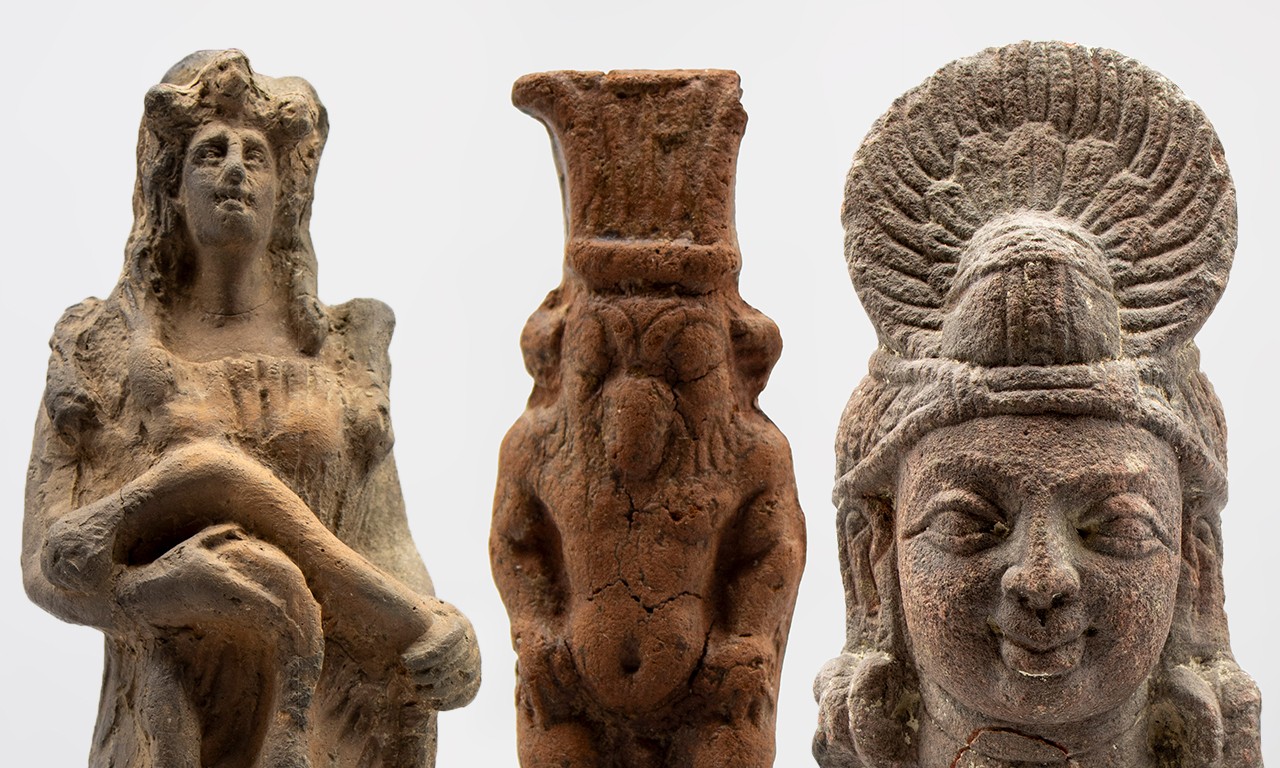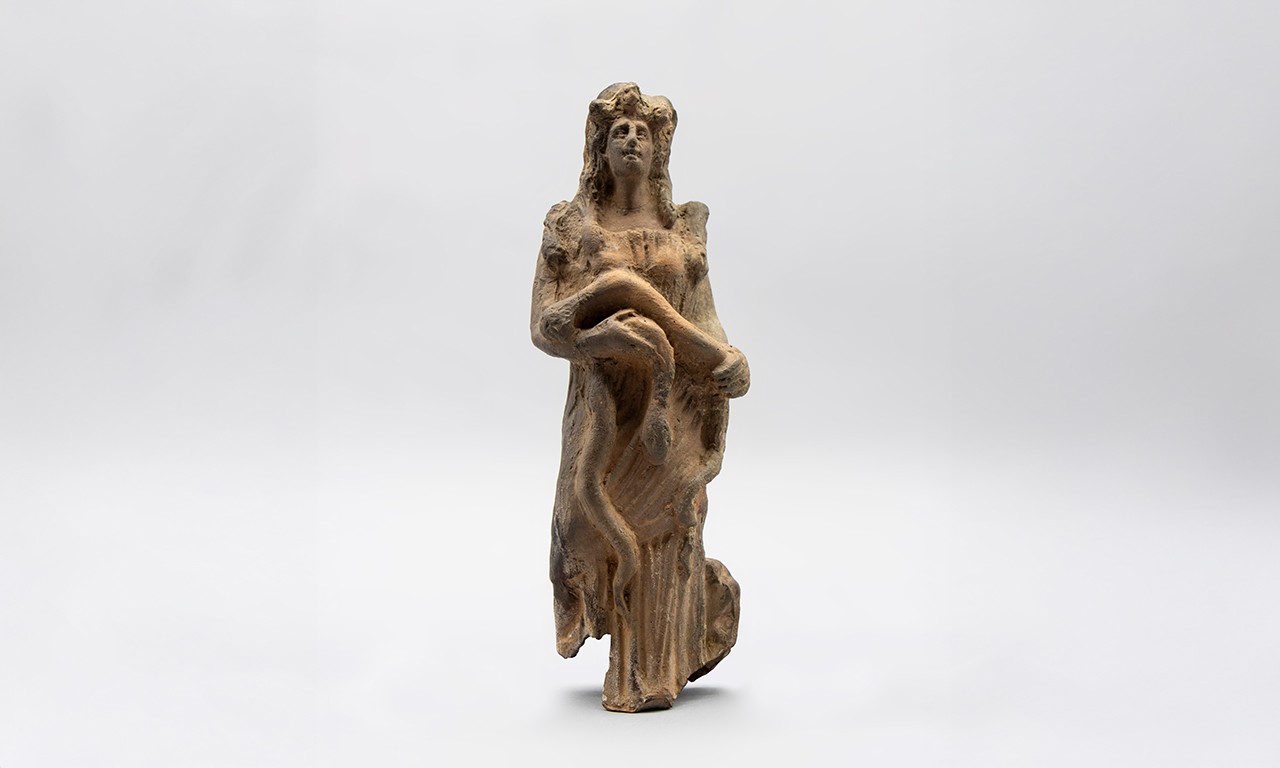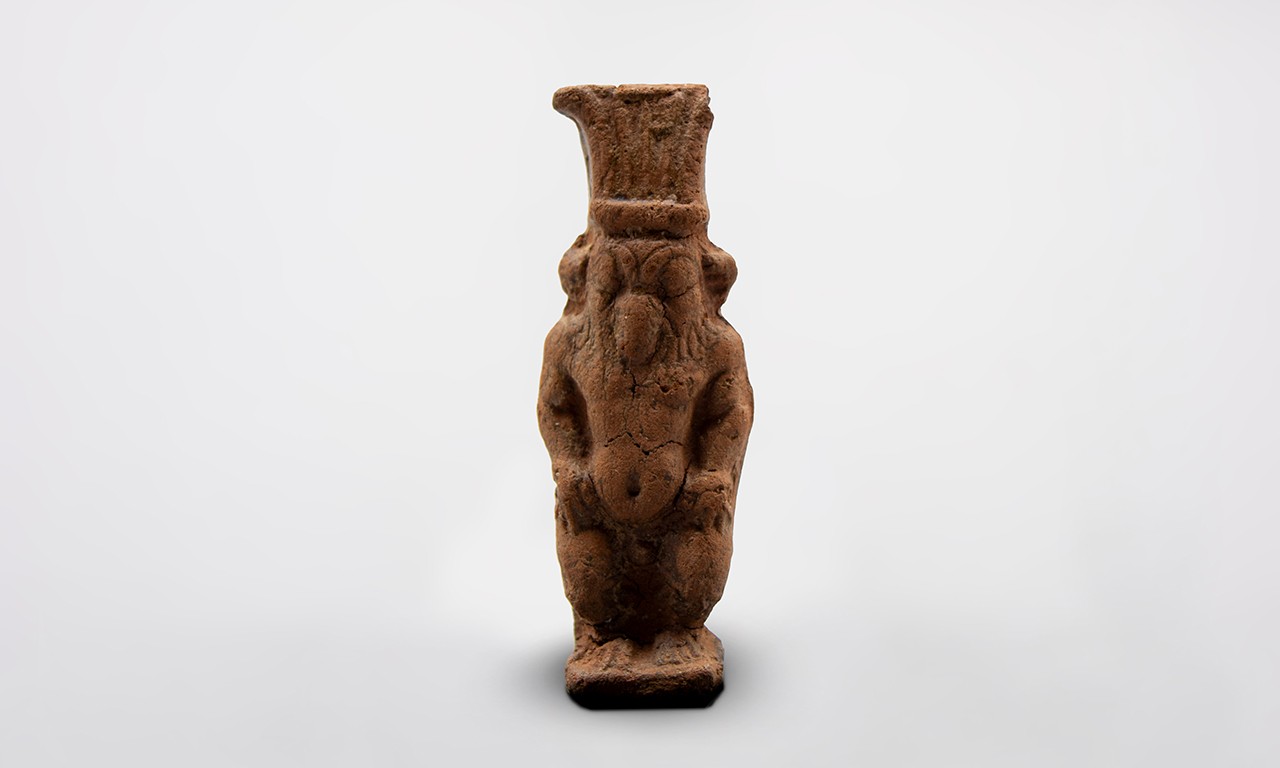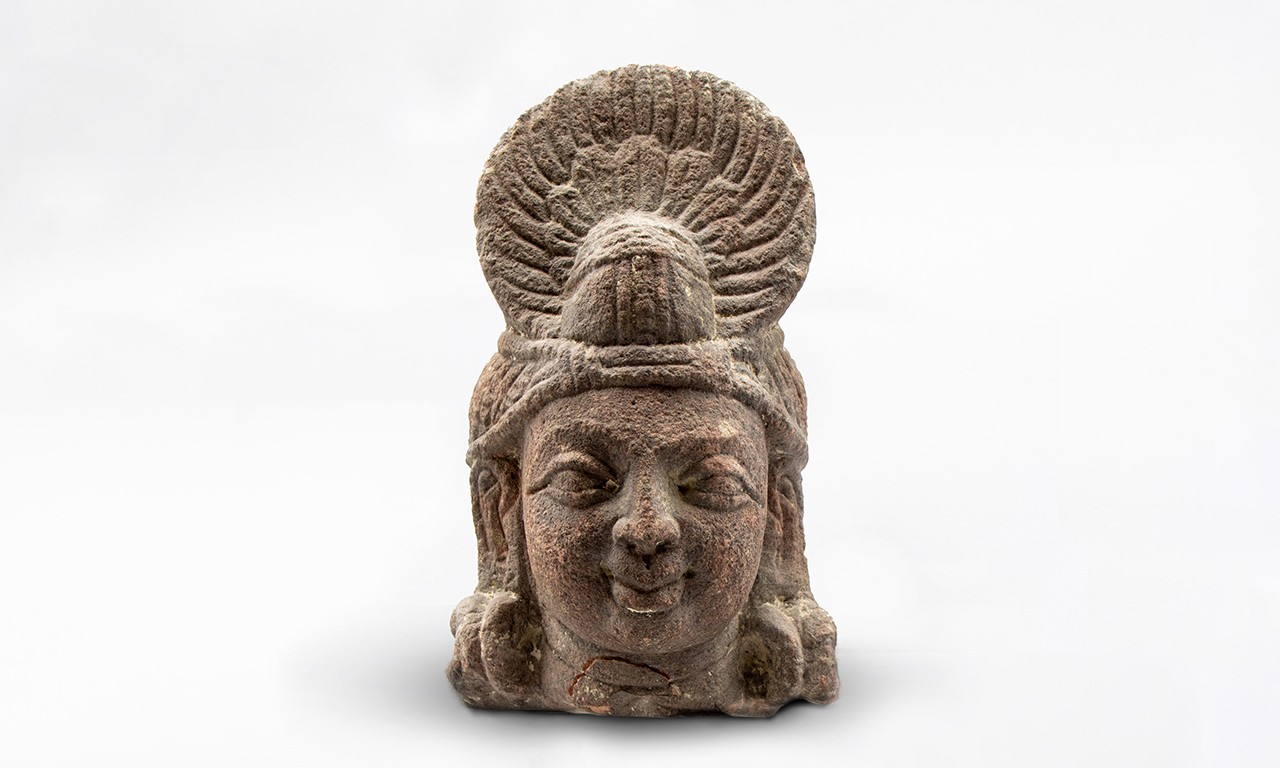 |
Tanagra Figurine
5th century
Boeotia, Greece
Terracotta; 7 in.
Bowers Museum Purchase, 78.34.1 |
Bes Figurine
c. 800 BCE
Sais culture; Egypt
Terracotta; 2 ½ in.
Gift of Mr. and Mrs. Jay Ward, 92.13.15 |
Goddess Relief
5th to 6th century
Gupta Empire; India
Terracotta; 18 x 12 in.
Gift of Dr. John B. Ross, 91.52.3 |
In anticipation of the exhibition, World of the Terracotta Warriors: New Archaeological Discoveries in Shaanxi in the 21st Century, which is open to the public May 24 through October 19, 2025, this blog post looks at objects from our collection and discusses the diverse uses of terracotta across ancient cultures from around the world.
The use of clay antedates recorded human history. Clay is tactile to the touch and hardens under low levels of heat. The term terracotta, derived from Latin for “baked earth,” has a few definitions, but here refers to ceramics that retain at least some of the reddish-brown hue of clay. The accessibility, malleability, durability, and portability of clay has made it an ideal material for early humans to create from vessels, ornaments, figures, decorative and votive objects, as well as architectural elements. Terracotta figures often survive through the centuries and provide us with a vivid impression of what life may have been like for earlier humans.
 |
| Bowers Museum Purchase, 78.34.1 |
Greek Tanagra Figurine
This Greek Tanagra figurine depicts a female protector wearing a chiton, a traditional Greek tunic that envelops the length of her body. The woman is poised in contrapposto and cradles a serpent in each arm. More serpents are visible in the long tresses of her coiffure. Also notable are the visually striking folds of the flowing chiton that provide the impression of organic movement in the subject.
Tanagra figurines derive their name from the site in Boeotia, in east-central Greece, where they were discovered in the late 19th century, and are significant for their recurring depiction of draped Greek women in everyday scenes, often in attire suited for domestic life; less common depictions include those of entertainers, men, and children. The figurines have supplied scholars with a myriad of theories about what life may have been like for Greek women during the Hellenistic period. What is most interesting about the Tanagra figurine in our collection is the ambiguous serpent motif that hosts a paradox of meanings in Greek mythology. The serpent can symbolize divinity, wisdom, healing and rebirth, fertility, as well as protection and is associated with many Greek guardians and deities. Nonetheless, the serpent motif pointedly distinguishes the figurine’s ritual function.
Although Tanagra figurines have been discovered in great quantities in graves in Tanagra in Boeotia, and throughout Greece, some scholars have questioned whether the rural center would have been capable of producing these figurines that reflect a strong cosmopolitan character. It is unlikely that an artisan from the rural center would have known the trends, aesthetic values, and fashion that would have constituted feminine beauty at the time. A more likely possibility is that these figurines originated in Athens where similar figurines were spread and broken over graves as part of a custom.
 |
| Gift of Mr. and Mrs. Jay Ward, 92.13.15 |
Figurine of the Deity Bes
In contrast to Tanagra figurines that emphasize realism and beauty, this terracotta figurine is a stylized depiction of the intentionally unsightly Egyptian deity Bes. The minor deity was widely revered throughout the Nile Valley since predynastic times and his multivalent iconography has been found on a variety of objects, architectural elements, and personal belongings: bedroom furniture, toiletry items, game pieces, amulets, musical instruments, weapons, armor, as well as on reliefs, frescoes, ostraca, and papyrus.
Bes is depicted as a grotesque dwarf with powerful muscles, a protruding belly, and lewd bestial visage depending on the context the deity appears in. Other common depictions of the deity include Bes as a warrior ready and equipped for war, Bes as a musician and jovial entertainer that deters evil spirits, and Bes as a leonine hybrid associated with the protection of the household, fertility, and childbirth.
Here, Bes is vigilant and sits with the palms of his hands resting on his thighs. The deity is depicted with bulbous eyes, round ears, thick, arched eyebrows, leonine-claws for feet, a pudgy nose, and wide teeth-baring grimace. The deity is also shown almost entirely in the nude with the exception of the plume headdress on his head. Leonine features, seen here in the form of claws for feet, were used in the depictions of mythical Egyptian beasts like Bes, the sphinx, griffin, and Taweret, another protective deity of childbirth and fertility. Lions were viewed by the ancient Egyptians as a symbol of royal power. Consequently, these mythical beasts served as the guardians of peoples and places.
The prevalence of Bes’ multivalent iconography across ancient Egypt can be attributed to the deity’s hybrid identity as a leonine-anthropomorphic beast, which made the deity’s image suitable to adaptation. It can also be attributed to the complex portrayal of Bes as an almost humorous amalgam of dichotomous traits, who is at once divine and demonic, fierce and jovial, and grotesque and charming. Ultimately, the Bes figurine represents a uniquely intimate theology, one in which divinity and protective magic was invited into the home through portable and personal objects.
 |
| Gift of Dr. John B. Ross, 91.52.3 |
Goddess Relief
Perhaps the most enigmatic object featured in this post is this terracotta relief, which we know very little about. The female figure’s smiling expression is framed beneath a plume headdress tied by a floral band and ushnishna, the cranial protuberance on the top of the head of a Buddha associated with enlightenment. She is depicted with wide almond-shaped eyes, full lips, a youthful complexion, symmetrical nose, and elongated earlobes from which disc earrings hang down to her shoulders. While it is unclear precisely who we are viewing, we can infer from the figure’s various Buddha features, that she is a divine being from Hindu and Buddhist origin. Further, the plume headdress and floral band indicate that this relief may more closely represent a yakshi, a female nature spirit, or mother goddess.
Based on the style and production method, this relief was likely produced in northern India sometime between the fifth and sixth centuries century under the patronage of the Gupta dynasty during which art and architecture thrived and fell in favor of naturalism and refined forms closely conforming to the prevailing religious vision. Large and elaborate plaques were produced to decorate the stupas and temples built during this period of religious fervor. This relief, thus, may be a fragment of such a plaque. The didactic intent of early relief was abandoned and replaced by serene illustrations of Buddha figures in proportion to their inner spiritual beauty and divinity. Here, the mother goddess personifies the ideal of the young mother in the form of a nature spirit associated with fertility.
Conclusion
The examples of terracotta discussed in this blog demonstrate the material's significance to the development of early artistic expression. The ability to produce terracotta importantly provided ancient cultures with greater means to cultivate their customs, cultural values, religious beliefs, and social structures. Besides what records written by the literate elite reveal to us, terracotta discoveries represent the potential for a less adulterated narrative, one shaped by the hands of artisans and representative of ordinary people. Not only does terracotta provide scholars with ideas about the past, but also how these peoples may have in fact viewed themselves. Discoveries of terracotta continue to reveal a history of ancient cultures not so intrinsically different from us. Together, these terracotta expressions remind us that clay is a potent conduit for enduring cultural meaning that offers a textured and embodied record of the universality of human expression.
Text and images may be under copyright. Please contact Collection Department for permission to use. References are available on request. Information subject to change upon further research.





Comments